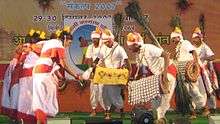Vanavasi Kalyan Ashram
Vanavasi Kalyan Ashram is an Indian social welfare organization based in Jashpur, in the Chhattisgarh state of India. It focuses on the welfare activities of Janjatis, that is Scheduled Tribes in remote areas of Bharat (India), and has branches throughout the country. These branches focus on agriculture, healthcare, child education, and sports. It also works to create cultural awareness among janjatis thereby facilitating the idea of preservation of their tradition and customs followed in different groups.[1]
 | |
| Founded | December 1952 |
|---|---|
| Founder | Balasaheb Deshpande |
| Focus | Tribal and indigenous communities of India |
| Location |
|
Area served | Health care, education |
Parent organization | Rashtriya Swayamsevak Sangh |
| Affiliations | Sangh_Parivar |
| Website | www |
The organization is a constituent of the Sangh Parivar, the family of organisations affiliated with the Hindu nationalist Rashtriya Swayamsevak Sangh (RSS).[2][3]
History

The Ashram was founded in 1952 by Ramakant Keshav Deshpande (also known as Balasaheb Deshpande), an official of the Orissa State Department of Tribal Welfare, with the support of the State Government and the RSS. After Independence, Balasaheb was appointed by the then Ravi Shankar Shukla Government to work in tribal-dominated Jashpur area as ‘Regional Officer’ of the ‘Tribal Development Scheme’. This particular area had gone into the iron grip of the Christian missionaries who had converted the simple tribal people to their religion by using all means fair and foul. Their conversion to Christianity had alienated them from the cultural and national moorings. Its aim was to counter the appeal of Christian missionary schools to the tribals. Based in Jashpur (214 km from Raigarh), it established schools in Raigarh and Surguja districts - areas with large tribal populations. The Ashram grew rapidly and a permanent office was established in 1963, inaugurated by the RSS chief M. S. Golwalkar.[2]
In 1977, during the Janata Party Government, it acquired national status (expressed in its new name, Bhāratiya Vanavāsi Kalyān Āshram). From 1978 to 1983, the number of its full-time volunteers rose from 44 to 264 (56 of whom were tribal). In Jashpur, a hospital was established, and schools, hotels, and centers for an apprenticeship in manual trades were also established in 40 villages. The programs are presently located in 312 districts throughout the country and are supervised by more than a thousand full-time workers. While most districts have primary schools, many other places have residential schools, hostels, libraries, and health centers. Important annual events include establishing medical camps, playing traditional sports, and celebrating tribal festivals.[2]
See also
- Swami Lakshamanananda
References
- Rath, Govinda Chandra (2006). Tribal development in India.
- Jaffrelot, Christophe (1996). The Hindu nationalist movement and Indian politics: 1925 to the 1990. London: C Hurst & Co. (Publishers) Ltd. pp. 322–323. ISBN 1-85065-301-1.
- "Adivasi vs Vanvasi: The Hinduization of Tribals in India". Outlook. 20 November 2002. Retrieved 8 December 2014.
External links